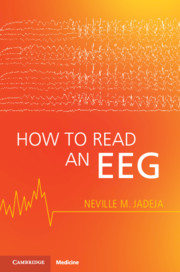Book contents
- How to Read an EEG
- How to Read an EEG
- Copyright page
- Dedication
- Contents
- Figure Contributions
- Foreword
- Preface
- How to Read This Book
- Part I Basics
- Part II Interpretation
- Part III Specific Conditions
- Chapter 18 Common Seizure Mimics
- Chapter 19 Seizures
- Chapter 20 Epilepsies
- Chapter 21 Epilepsy Syndromes
- Chapter 22 Focal Dysfunction (Lesions)
- Chapter 23 Global Dysfunction (Encephalopathy)
- Chapter 24 Status Epilepticus
- Chapter 25 Post Cardiac Arrest
- Chapter 26 Brain Death
- Appendix How to Write a Report
- Index
- References
Chapter 20 - Epilepsies
from Part III - Specific Conditions
Published online by Cambridge University Press: 24 June 2021
- How to Read an EEG
- How to Read an EEG
- Copyright page
- Dedication
- Contents
- Figure Contributions
- Foreword
- Preface
- How to Read This Book
- Part I Basics
- Part II Interpretation
- Part III Specific Conditions
- Chapter 18 Common Seizure Mimics
- Chapter 19 Seizures
- Chapter 20 Epilepsies
- Chapter 21 Epilepsy Syndromes
- Chapter 22 Focal Dysfunction (Lesions)
- Chapter 23 Global Dysfunction (Encephalopathy)
- Chapter 24 Status Epilepticus
- Chapter 25 Post Cardiac Arrest
- Chapter 26 Brain Death
- Appendix How to Write a Report
- Index
- References
Summary
Epilepsy is a disorder of recurrent unprovoked (or reflex) seizures; the key to diagnosing epilepsy is estimating the risk of recurrence. Epilepsy may be diagnosed if a patient has two or more seizures at least 24 hours apart, a first-time seizure with factors that increase the risk of recurrence, or an epilepsy syndrome. When determining the type of epilepsy, first identify the seizure type(s), then the corresponding epilepsy type. Consider if the epilepsy is potentially syndromic or nonsyndromic. Consider the underlying etiology (structural, genetic, infectious, immune, or metabolic). Focal epilepsies may be classified based on their region of onset, that is, frontal, temporal (mesial/lateral), parietal, occipital, or insular. Ictal and interictal EEG findings vary with the type of focal epilepsy.
- Type
- Chapter
- Information
- How to Read an EEG , pp. 187 - 194Publisher: Cambridge University PressPrint publication year: 2021

